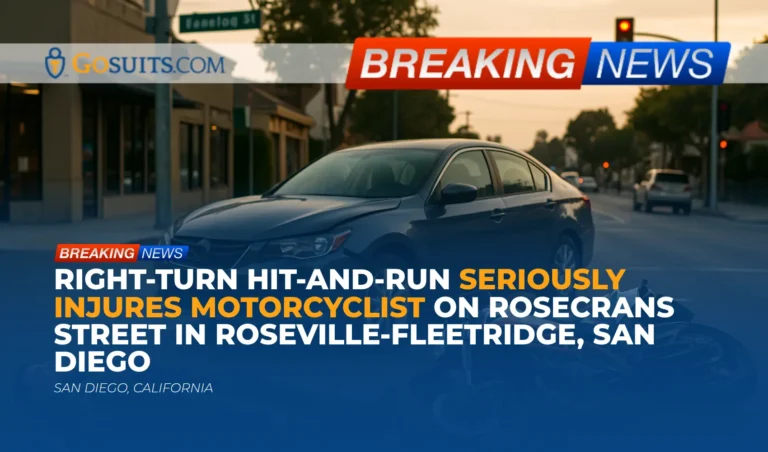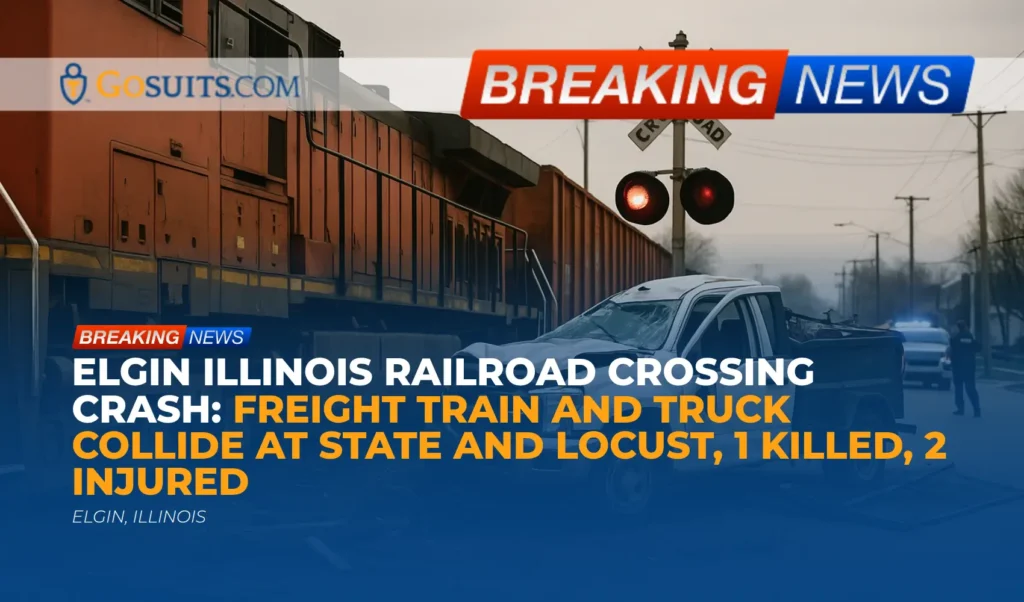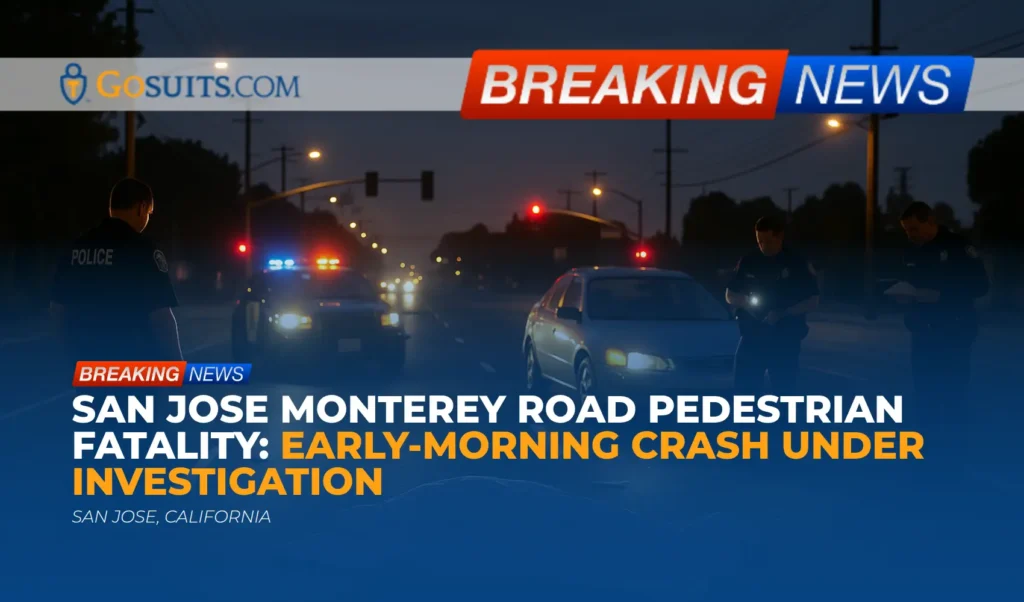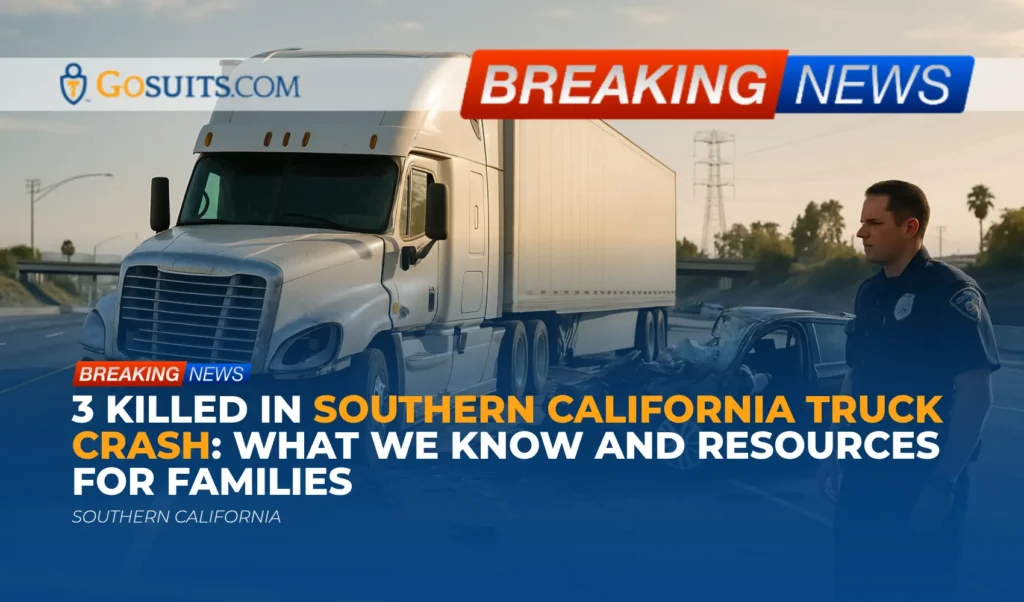- What is known about the Roseville-Fleetridge motorcycle hit-and-run
- Where and when the crash happened
- Why right-turn collisions endanger motorcyclists
- California law on stopping after crashes and why it matters for civil claims
- Potential civil liability in right-turn crashes
- Insurance pathways after an unidentified hit-and-run
- Immediate steps to consider after a motorcycle hit-and-run
- How to obtain official records, reports, and helpful documentation
- How investigations unfold and how evidence can surface
- Key rights and timelines to keep in mind in California
- Local safety context near Rosecrans Street and Fenelon Street
- Helpful contacts and resources
- Commentary from Gosuits San Diego, California Personal Injury Attorney
- Why acting soon matters: a practical next-steps note
What is known about the Roseville-Fleetridge motorcycle hit-and-run
Authorities reported that a 42-year-old motorcyclist was seriously injured in a hit-and-run collision in the Roseville-Fleetridge community of San Diego. According to information attributed to the San Diego Police Department, the crash occurred around 6:30 p.m. on a Saturday in the 1400 block of Rosecrans Street. The rider, operating a KTM motorcycle and traveling southbound approaching Fenelon Street, was struck when an unknown vehicle, also traveling southbound, turned right onto Fenelon Street and made contact with the motorcyclist. The motorist left the scene. Paramedics transported the rider, who sustained a knee injury, to a hospital for treatment. Anyone with information was asked to call Crime Stoppers at 888-580-8477.
Hit-and-run collisions can compound harm by delaying medical care, complicating investigations, and putting all road users at risk. In this case, the report indicates a right-turn movement by the unknown vehicle leading to impact with a southbound motorcyclist, followed by a flight from the scene.
Where and when the crash happened
The collision was reported in the 1400 block of Rosecrans Street near Fenelon Street in the Roseville-Fleetridge neighborhood of San Diego. The time of day was approximately 6:30 p.m. on a Saturday. This is a mixed-use corridor with commercial activity, driveways, and multiple intersecting streets. Early evening light, traffic patterns, and the presence of turning movements can influence visibility and driver decision-making.
Even with limited details released, the described movement pattern is one that traffic safety professionals frequently identify as hazardous for people on motorcycles: a vehicle turning across or into the path of a two-wheeler traveling straight.
Why right-turn collisions endanger motorcyclists
Motorcyclists face unique risks because of their narrow profile, limited conspicuity, and lack of protective structure. When a vehicle makes a right turn from a through lane or from a shared lane without ensuring enough space and time, a rider traveling straight can be sideswiped or cut off, leading to loss of control or direct impact. Several factors can contribute to these crashes:
- Limited visibility or “looked-but-did-not-see” errors where a driver glances and fails to perceive the approaching motorcycle.
- Improper lane positioning during the turn, including swinging wide or turning from the wrong lane, encroaching on the rider’s path.
- Failure to signal or check blind spots before initiating the turning movement.
- Speed and gap misjudgment, where the driver underestimates the motorcycle’s approach speed or proximity.
- Environmental conditions such as dusk lighting, glare, or visual clutter from signs and storefronts that mask the rider.
National safety research underscores that motorcyclists are disproportionately harmed in multi-vehicle crashes involving turning movements. Federal data have long recognized the higher severity of injuries among riders due to exposure. For general background on motorcycle safety, see the National Highway Traffic Safety Administration’s information page on motorcycles at NHTSA.
California law on stopping after crashes and why it matters for civil claims
Under California law, any driver involved in a collision has clear duties. When a crash results in injury or death, drivers must immediately stop at the scene, provide identifying information, and render reasonable assistance. Failing to do so is a serious offense under state statute. While the criminal ramifications are handled by law enforcement and the courts, the civil significance is straightforward: leaving the scene can make it harder for injured people to identify the at-fault motorist and access insurance coverage.
Relevant statutes include:
- Duty to stop and render aid in injury collisions: California Vehicle Code sections 20001–20003 outline obligations for drivers to stop, exchange information, and assist injured persons.
- Duty to drive and turn safely: California law requires that no person turn a vehicle until such movement can be made with reasonable safety and after giving an appropriate signal when required. See Vehicle Code section 22107 at the state legislative portal: leginfo.legislature.ca.gov.
From a civil perspective, when a driver fails to stop, it can complicate any claim for losses because the responsible party is initially unknown. However, California insurance law provides avenues for people injured by unidentified motorists, as discussed below.
Potential civil liability in right-turn crashes
In a turning crash, investigators and insurers typically examine whether the turning driver violated traffic duties such as failing to signal, failing to ensure the lane change or turn could be made safely, or failing to yield to a vehicle with the right-of-way. For motorcyclists, even a momentary incursion into their space can cause severe injury due to instability or ejection.
California uses a comparative fault system. That means responsibility can be shared if multiple factors contributed, and any damages can be reduced by a person’s percentage of responsibility. In a right-turn context, questions often include: Did the turning vehicle signal and check mirrors and blind spots? Was the turn made from the correct lane? Was the rider visible and proceeding lawfully in the lane? Did the driver encroach or cut across the rider’s path?
In the report summarized here, the unknown vehicle’s right turn into the path of a southbound motorcycle raises issues commonly associated with driver liability. When the driver is identified, a claim would ordinarily be evaluated under these civil duty standards within California’s negligence framework.
Insurance pathways after an unidentified hit-and-run
When the at-fault driver is unknown, California riders often look to their own automobile or motorcycle policy for coverage. Common coverages include:
- Uninsured Motorist Bodily Injury (UMBI): In California, UMBI typically applies when a driver who caused the crash has no insurance or is unidentified in a hit-and-run. Policies vary, and some impose conditions, so it is important to review the policy language carefully. California’s uninsured motorist requirements are codified in Insurance Code section 11580.2.
- Medical Payments (MedPay): Optional coverage that may help pay reasonable medical expenses for the insured rider and passengers regardless of fault, subject to policy limits and terms. The California Department of Insurance provides consumer guidance on auto coverages at the state’s official site: insurance.ca.gov.
- Collision coverage: May help repair or replace the motorcycle after a crash, minus any deductible, regardless of whether the at-fault driver is identified.
Before speaking with any insurance company, it is prudent to consult a qualified attorney for a free consultation about rights and strategy. Statements given to insurers can affect future claims, and what is said may be cited later in the process.
Immediate steps to consider after a motorcycle hit-and-run
Every situation is unique, and safety and medical needs come first. Generally, steps that tend to help protect health and legal rights include:
- Seek medical evaluation immediately and follow medical advice. Knee trauma and other orthopedic injuries may not fully declare themselves for hours or days. Early records help document causation and severity.
- Report the crash to law enforcement. In San Diego, collisions can be reported through the San Diego Police Department. If you are still at the scene and it is safe to do so, call 911 for emergencies. For non-emergencies, use SDPD’s published non-emergency numbers.
- File the DMV SR-1 report if required. California requires that a traffic collision be reported to the DMV within 10 days if there was injury, death, or property damage above a set threshold. The SR-1 form and instructions are available on the California DMV site at dmv.ca.gov.
- Preserve evidence. Save helmet cam or bike camera footage, photos, torn clothing, and damaged gear. Request that nearby businesses preserve surveillance video. Document skid marks, debris patterns, and resting positions if safely possible.
- Identify witnesses. Collect names, phone numbers, and any recollections of vehicle descriptions, partial plates, or distinctive markings. Even small details can help investigators and insurers.
- Document your injuries and recovery. Keep a journal of symptoms, doctor visits, lost time from work, and the ways the injury affects daily activities.
- Consult an attorney before contacting insurers. A brief consultation can help clarify coverage options and pitfalls. What you report to any insurer can be used to evaluate or challenge the claim.
How to obtain official records, reports, and helpful documentation
Accessing official records can be important for insurance claims and potential civil actions. The following avenues are commonly used in San Diego and throughout California:
San Diego Police Department collision report
The San Diego Police Department Records Unit provides access to eligible police reports, including traffic collision reports when available. Visit the City of San Diego’s official page for records services at sandiego.gov/police/services/records for instructions, hours, and any applicable fees. You can also inquire by phone using the department’s published numbers.
Public records requests to the City of San Diego
Certain materials such as 911 audio, Computer Aided Dispatch (CAD) logs, or city-held traffic camera footage may be requested under the California Public Records Act. The City’s official public records page provides guidance on how to submit a request: sandiego.gov/public-records. Note that response timelines and exemptions apply, and some records may be withheld or redacted by law.

California DMV accident reporting
If the crash meets the criteria for reporting, the SR-1 accident report must be filed with the DMV within 10 days. Details and the SR-1 form are available at the DMV’s official site: dmv.ca.gov.
Medical and ambulance records
Patients have a legal right to obtain copies of their medical records. Guidance from the U.S. Department of Health and Human Services on access to medical records is available at hhs.gov. For local emergency medical services or ambulance records, inquiries can be directed to the responding agency; in San Diego, this may involve San Diego Fire-Rescue for EMS responses.
If a crash involved a fatality
In fatal incidents, the San Diego County Medical Examiner handles death investigations and related records. The county provides information on procedures and record requests at sandiegocounty.gov/me. This particular crash was reported as a serious injury event, not a fatality, but families in other cases may find this resource useful.
Crime victim resources
Victims of certain crimes, including some vehicle crimes, may be eligible for limited financial assistance through state programs. The California Victim Compensation Board provides information on eligibility and covered expenses at victims.ca.gov. Eligibility depends on the facts of each case and program rules.
How investigations unfold and how evidence can surface
Hit-and-run investigations often start with the injured person’s account, scene evidence, and any witness statements. Investigators may look for:
- Physical evidence such as paint transfer, plastic fragments, or unique tire marks that indicate vehicle type and color.
- Surveillance sources including doorbell cameras, storefront systems, or municipal cameras in the area.
- Traffic incident logs and dispatch recordings that may corroborate timing and location.
- Medical records that document injuries consistent with the crash mechanism.
- Public tips spurred by news coverage or Crime Stoppers notices.
As time passes, evidence can be lost. Nearby businesses may overwrite video automatically, sometimes within days. Preserving footage promptly can make a material difference in identifying a fleeing vehicle or narrowing the search.
Key rights and timelines to keep in mind in California
California sets deadlines that affect insurance claims and civil cases. Missing a deadline can limit options. Important timelines include:
- General statute of limitations for personal injury in California is generally two years from the date of injury. See California Code of Civil Procedure section 335.1 at the state’s official site: leginfo.legislature.ca.gov.
- Government claims: If a claim involves a public entity, California’s Government Claims Act often requires a written claim within six months for personal injury matters before filing a lawsuit. See Government Code section 911.2 at leginfo.legislature.ca.gov.
- DMV reporting: The SR-1 report to DMV is required within 10 days in crashes involving injury, death, or threshold property damage. Instructions are at dmv.ca.gov.
- Insurance notice provisions: Policies often require prompt notice of a claim. California’s uninsured motorist statute contains specific conditions. See Insurance Code section 11580.2. Consider consulting an attorney promptly to understand requirements.
- Victims’ rights: California’s constitutional Victims’ Bill of Rights, also known as Marsy’s Law, outlines rights of crime victims, including to be informed and heard in certain proceedings. See the Attorney General’s summary at oag.ca.gov. While primarily relevant to the criminal process, these rights can intersect with civil recovery efforts.
Local safety context near Rosecrans Street and Fenelon Street
Rosecrans Street is a busy north-south route serving local residents, businesses, and visitors moving between neighborhoods and coastal areas. At Fenelon Street, drivers may be turning into side streets, entering parking areas, or adjusting lanes as traffic ebbs and flows. In this setting, safe turning behavior is critical. Motorcyclists traveling straight have limited room to maneuver if a larger vehicle cuts across or turns into their path with little warning.
San Diego has adopted a Vision Zero framework aimed at preventing traffic deaths and serious injuries citywide. More information on the City’s road safety initiatives is available at the official page: sandiego.gov/vision-zero. A focus on consistent yielding, attentive scanning for smaller road users, and predictable signaling helps reduce conflict points like the one described in this report.
Helpful contacts and resources
The following information may assist individuals seeking documentation, updates, or support after a traffic collision in San Diego:
- Emergency: 911 for life-threatening situations or active incidents.
- San Diego Police Department
- Non-emergency numbers: 619-531-2000 or 858-484-3154.
- Records Unit and collision reports: sandiego.gov/police/services/records.
- Crime Stoppers tip line: 888-580-8477. Tips can help identify a fleeing driver.
- California DMV SR-1 accident reporting: dmv.ca.gov.
- City of San Diego Public Records: For 911 audio, CAD logs, or available city-held video, see sandiego.gov/public-records.
- Medical records access: Federal guidance on obtaining your own medical records is at hhs.gov.
- California Department of Insurance consumer guides: Auto insurance basics and coverage explanations at insurance.ca.gov.
- San Diego County Medical Examiner (for fatal incidents): sandiegocounty.gov/me.

Commentary from Gosuits San Diego, California Personal Injury Attorney
Our hearts go out to the injured rider and to everyone impacted by this crash. A hit-and-run compounds the shock of a collision with the distress of being left without answers. This commentary is offered for educational purposes and general information to help the community understand the civil issues that often arise after events like this.
Based on the description released by authorities, the critical movement appears to be a right turn by a southbound vehicle into the path of a southbound motorcycle approaching Fenelon Street. In civil terms, turning drivers must make sure a turn can be completed safely and must signal appropriately. When a turning vehicle sideswipes or cuts off a rider traveling straight, the civil analysis frequently focuses on whether the turning maneuver violated those duties. The driver’s flight from the scene adds difficulty, as it delays identification and insurance accountability, but it does not eliminate the rider’s potential avenues for recovery.
Insurance carriers and corporate entities involved in claims typically move quickly to minimize their exposure. Adjusters may request recorded statements soon after a crash, and they may characterize injuries as minor or unrelated without a full medical workup. In hit-and-run cases, questions about coverage, especially under Uninsured Motorist or MedPay provisions, can be used to discourage or delay valid claims. We see people unintentionally harming their own claims by giving statements before understanding how policy language, medical documentation, and California’s timelines interact.
That is why a free consultation can be valuable early on. Speaking with a seasoned and skilled advocate before engaging with insurers helps clarify rights and strategy. It also helps avoid common pitfalls, such as missing DMV reporting, overlooking evidence preservation, or making statements that are later used to limit or deny coverage.
Why acting soon matters: a practical next-steps note
- Preserve time-sensitive evidence: Many security systems overwrite video within days. Promptly asking nearby businesses to preserve footage can be decisive in identifying a fleeing vehicle.
- Protect health and documentation: Early medical evaluation not only supports recovery, it also creates a contemporaneous record that insurers rely upon when assessing claims.
- Meet legal and administrative deadlines: California’s DMV reporting, insurance notice provisions, and statutes of limitation are all time-bound. Acting early helps ensure no window is missed.
- Coordinate communications: Before contacting any insurer, consider getting legal guidance. What is said in early calls can influence claim outcomes and may be cited against the claimant later.
- Clarify coverage: Understanding how Uninsured Motorist, MedPay, and collision coverages apply in a hit-and-run helps set realistic expectations and prevents surprises.
- Support the investigation: Timely witness follow-up and record requests can uncover new leads. Even partial plate numbers or distinctive vehicle features may enable identification through official channels.
Taking these steps promptly helps safeguard options and supports a clearer path through an understandably stressful process.






